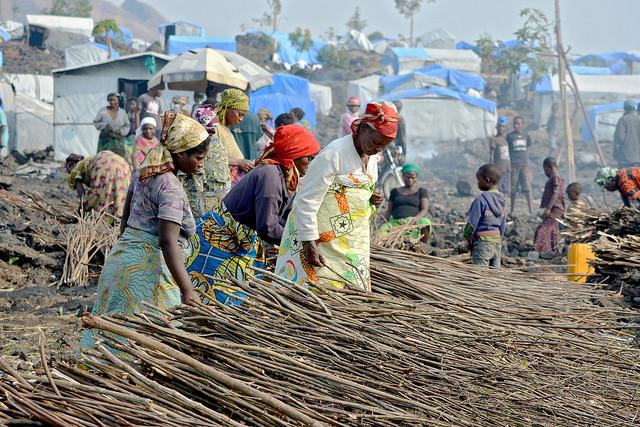
This article is the fifth in a series on ‘Women, Peace and Security’ that The Strategist will publish over coming weeks in recognition of International Women’s Day 2018. Eds.
According to the UNHCR, women and girls make up around 50% of the 65.6 million displaced people worldwide. They experience unique vulnerabilities when displaced by conflict, including increased risk of gender-based violence, trafficking and child marriage. They may also have compelling insights into conflict that could harness largely untapped capacities for peacebuilding. Protecting women and girls from such harms, and including them in peacebuilding efforts, are the foundations of the women, peace and security (WPS) agenda.
Yet very few Western states seek to align their domestic refugee and asylum policies with their WPS policymaking. In fact, there’s a general blind spot in WPS policymaking when it comes to ensuring the rights of displaced women worldwide.
Why is that? Some argue that the Security Council resolutions that constitute the WPS agenda address the experiences of women in conflict-affected zones, rather than the experiences of conflict-affected women who may have been displaced from their country of origin. Once women become stateless, the WPS responsibilities of UN member states to these women becomes opaque.
This is primarily because the WPS resolutions don’t require UN members who aren’t party to a conflict (such as Australia) to protect displaced women as a WPS concern.
Actions in the WPS resolutions relating to displaced women only apply to conflict parties and UN agencies. UN Security Council resolutions (UNSCR) 1325 (2000) and 1889 (2009) call upon parties to armed conflict to respect refugee camps and settlements. UNSCR 1325 also calls upon parties to armed conflict to ‘fully respect international law applicable to the rights and protection of women and girls, especially civilians’. The focus on conflict zones and actors seems to push displaced women to the margins for other member states like Australia.
However, five of the eight resolutions do speak of displacement in their preambles. In those preambles, the unique vulnerabilities of displaced women are acknowledged. Specifically, the preamble of UNSCR 2122 (2013) notes that ‘unequal citizenship rights, gender-biased application of asylum laws, and obstacles to registering and accessing identity documents’ underpin conflict-affected women’s vulnerabilities.
In addition, the preambles acknowledge the negative impact that women’s displacement has on peace and security. These consistent preambulatory references to displaced women clearly identifies them as a core focus of the WPS agenda.
So where does this leave UN member states like Australia in thinking through their WPS obligations to women displaced by conflict?
The actions identified in Australia’s current National Action Plan on Women, Peace and Security (NAP) are, at best, tokenistic. The Department of Immigration and Border Protection isn’t an implementing agency and the NAP’s implementation plan has only one relevant action—to ‘ensure Australia’s humanitarian assistance and recovery programs in conflict and post-conflict situations respect applicable international human rights and refugee law in regards to women and girls …’. That action is assigned to AusAID (now a part of DFAT).
Moreover, this action has no corresponding reporting measure. Consequently, there’s no monitoring under Australia’s current NAP of its engagement with conflict-affected displaced women. Nor is its domestic asylum or immigration policy required to align with the NAP. This is best evident in the current Rohingya crisis where DFAT acknowledges the unique experiences of women in responding to the crisis but this response doesn’t connect with asylum policy.
This presents an opportunity. The newly established Department of Home Affairs has a broad remit across domestic and foreign policy in a range of WPS-relevant areas. These include asylum policy, violent extremism, counterterrorism, and disaster management and recovery. The department clearly has a part to play in the design and implementation of the next Australian NAP.
Globally, we’re seeing such integration between asylum and WPS policies in a number of countries:
- The first Irish NAP (2011) includes strong language on the links between displacement and WPS: ‘Ireland’s first NAP advances understanding of the obligations of UNSCR 1325 … to include reference to migrant women and girls, including asylum seekers, affected by conflict’.
- The second French NAP (2015) commits the country to ‘increase consideration of issues linked to gender and violence against women in asylum procedures’.
- Canada’s 2017 NAP includes its immigration agency as a supporting NAP partner with its own implementation plan.
These approaches might provide some inspiration for how the Department of Home Affairs might be involved in the second NAP. First, they offer a more generous reading of the UNSCRs by considering the circumstances of conflict-affected women wherever they reside.
Second, they commit to provisions such as prioritising and supporting conflict-affected women through asylum assessment systems, facilitating their settlement and integration, and addressing their unique vulnerabilities after settlement.
Third, they endeavour to align NAPs with both domestic policy (such as asylum and countering violent extremism policies) and other international instruments—in particular the Convention on the Elimination of All Forms of Discrimination Against Women, which has strong WPS reporting that can be leveraged in NAPs.
In creating a system for conflict-affected women that treats them with respect throughout their journey from their homeland to resettlement, these states also create coherence between their domestic and foreign policy. As Australia begins to design its next NAP, this should provide food for thought.